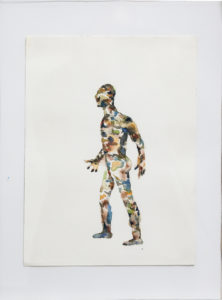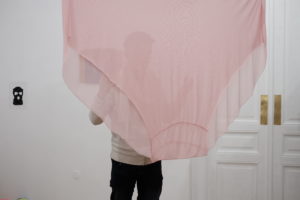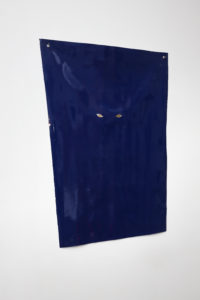The following texts were part of a Fanzine edition presented during the exhibition:
The exhibition took place at Hidegszoba Studio, Budapest in 2019.
POWER OF OBJECTS
Sophie Horvath
In common usage the sexual connotations of the word fetish are often prioritized over its other meanings, but the origin of the word is linked to the history of European colonialism and the development of anthropology in the 18th century. Feticio in Portuguese is derived from the Latin facticius : fabricated, artificial, or even enchanted, and was first used during the Portuguese expeditions in Guinea to designate inanimate cult objects. In Bruno Latour’s* fictional comic dialogue, Christian colonizers, covered with crosses and amulets of the Virgin Mary question, with ironical contempt, the indigenous people on their beliefs in the divinity of the fetishes that they have fabricated: “You can’t say at the same time that you have fabricated your fetishes and that they are divinities, you must choose one or the other…” Broadly, a fetish is a fabricated item that has an overwhelming power that influences its creators. The nail statuettes from Congo, the Minkisi, reveal another aspect of the paradoxical nature of fetishes: they are not only mediators or incarnations of divinities that can be petitioned, they also allow us to control the powers exercised by the divinities that influence our destinies. It is thus no accident that etymologically fetish incorporates the idea of destiny, fatum. There is a reciprocity between the power of the Gods to whom we submit and the attempt to control them through the fetishes we create.
The strangeness of other cultures raise questions that in turn question our own culture. It is this type of reflexive questioning, influenced by anthropology, that was subsequently integrated into psychoanalysis and theories of political economy theories (Marx) through the idea of alienation linked to fetishism. The word fetish still bears this pejorative aspect, denouncing a false, distorted relation to different types of power, but it also interrogates reflexively their sources and their limits ; not only the limits which are imposed on us but those which we impose ourselves. Transgression today doesn’t have the same meaning as 100 years ago, the boundaries of normality and pathology are moving, as well as the power structures described by Marx’s political economy. To draw these limits is also to raise questions about the contours of our identity, here through representations of the body and its masks. These are questions and paradoxes involving power relations that are posed by fetish-objects and masked bodies, which reveal the underground connexions between apparently disparate topics, such as sexual fetishism, voodoo statues and commodity fetishism. Artworks can be added to these.
*Bruno Latour in Petite réflexion sur le culte moderne des dieux faitiches, 1996,Prologue.
***************************
ABOUT SOME WORKS
Sophie Horvath
The morphsuit (Japanese zentai) are stocking-like costumes which tightly cover the body and head – aiming at erasing any individuality in order to melt into the anonymity of a community. But this gesture of submission which negates individuality paradoxically coincides precisely with what is constitutive of individuality itself : the body. The subject, the individual is deliberately transformed into a fetish-object, and there is no longer any distance – as with the fetishization of external objects – between desire and its object. The desire or subject of desire becomes an object and vice-versa…

Camouflage-zentai, 2018
The « camouflage » zentai is a blatant example of the body displaying the attributes of invisibility.
The morphsuit, or zentai, provides a strange counterpoint to nudity, which is so willingly claimed nowadays to be freedom, rebellion : the morphsuit isfrom a certain point of view the refusal to accept this so-called freedom. On the other hand, it at the same time makes a claim to a form of « transparency », that of the naked desire, materialized by the integral stocking – which finally raises the question of its… opacity.

The big slip, 2018
The big transparent slip («The Big Slip») is a metaphor for the display of a secret. The slip is only an object of desire because it refers to something else, something hidden: sex; it is an « open secret ». The transparency of the slip is this symbol of the open secret illustrating Michel Foucault’s idea that modernity constantly talks about sex while putting it forward as «the» secret. What is presented as transparency is what we could describe as the mask of opacity. Descartes: Larvatus prodeo = I advance masked. Transparency (Glasnost) has also become a political mask.

Spirit, 2018
The idea behind the work « Spirit », that consists only of a piece of plastic tablecloth with eyes made out of mirrors, comes from a film by the anthropologist Guy Le Moal, Le Grand Masque Molo (1968), where a family builds a mask from a tree trunk: the moment when the eyes are carved is the moment the mask becomes sacred and alive.
***************************
ADDED TEXTS (These were quotes added at the end of the Fanzine)
ETIENNE DE LA BOETIE
Discourse on Voluntary Servitude (1548)[3]
p.1 For the present I should like merely to understand how it happens that so many men, so many villages, so many cities, so many nations, sometimes suffer under a single tyrant who has no other power than the power they give him; who is able to harm them only to the extent to which they have the willingness to bear with him; who could do them absolutely no injury unless they preferred to put up with him rather than contradict him. Surely a striking situation! Yet it is so common that one must grieve the more and wonder the less at the spectacle of a million men serving in wretchedness, their necks under the yoke, not constrained by a greater multitude than they, but simply, it would seem, delighted and charmed by the name of one man alone whose power they need not fear, for he is evidently the one person whose qualities they cannot admire because of his inhumanity and brutality toward them.
*
A people enslaves itself, cuts its own throat, when, having a choice between being vassals and being free men, it deserts its liberties and takes on the yoke, gives consent to its own misery, or, rather, apparently welcomes it.
***************************
MICHEL FOUCAULT (1976)
History of sexuality p. 49
« What is peculiar to modern societies is not that they consigned sex to a shadow existence, but that they dedicated themselves to speaking of it ad infinitum, while exploiting it as the secret. »
***************************
KARL MARX (1867)
Capital Volume One Part SECTION 4
THE FETISHISM OF COMMODITIES AND THE SECRET THEREOF
A commodity appears, at first sight, a very trivial thing, and easily understood. Its analysis shows that it is, in reality, a very queer thing, abounding in metaphysical subtleties and theological niceties. So far as it is a value in use, there is nothing mysterious about it, whether we consider it from the point of view that by its properties it is capable of satisfying human wants, or from the point that those properties are the product of human labour. It is as clear as noonday, that man, by his industry, changes the forms of the materials furnished by Nature, in such a way as to make them useful to him. The form of wood, for instance, is altered, by making a table out of it. Yet, for all that, the table continues to be that common, everyday thing, wood. But, so soon as it steps forth as a commodity, it is changed into something transcendent. It not only stands with its feet on the ground, but, in relation to all other commodities, it stands on its head, and evolves out of its wooden brain grotesque ideas, far more wonderful than “table-turning” ever was.
There is a physical relation between physical things. But it is different with commodities. There, the existence of the things qua commodities, and the value relation between the products of labour which stamps them as commodities, have absolutely no connection with their physical properties and with the material relations arising therefrom. There it is a definite social relation between men, that assumes, in their eyes, the fantastic form of a relation between things. In order, therefore, to find an analogy, we must have recourse to the mist-enveloped regions of the religious world. In that world the productions of the human brain appear as independent beings endowed with life, and entering into relation both with one another and the human race. So it is in the world of commodities with the products of men’s hands. This I call the Fetishism which attaches itself to the products of labour, so soon as they are produced as commodities, and which is therefore inseparable from the production of commodities.
***************************
GUY DEBORD (1967)
The Society of the spectacle
1.
In societies where modern conditions of production prevail, all of life presents itself as an immense accumulation of spectacles. Everything that was directly lived has moved away into a representation.
4.
The spectacle is not a collection of images, but a social relation among people, mediated by images.
30.
The alienation of the spectator to the profit of the contemplated object (which is the result of his own unconscious activity) is expressed in the following way: the more he contemplates the less he lives; the more he accepts recognizing himself in the dominant images of need, the less he understands his own existence and his own desires. The externality of the spectacle in relation to the active man appears in the fact that his own gestures are no longer his but those of another who represents them to him. This is why the spectator feels at home nowhere, because the spectacle is everywhere.
37.
This is the principle of commodity fetishism, the domination of society by “intangible as well as tangible things,” which reaches its absolute fulfilment in the spectacle, where the tangible world is replaced by a selection of images which exist above it, and which simultaneously impose themselves as the tangible par excellence.
45.
Automation, the most advanced sector of modern industry as well as the model which perfectly sums up its practice, drives the commodity world toward the following contradiction: the technical equipment which objectively eliminates labor must at the same time preserve labor as a commodity and as the only source of the commodity.
67.
We can recognize a mystical abandon to the transcendence of the commodity in free gifts, such as key chains which are not bought but are included by advertisers with prestigious purchases, or which flow by exchange in their own sphere. One who collects the key chains which have been manufactured for collection, accumulates the indulgences of the commodity, a glorious sign of his real presence among the faithful. Reified man advertises the proof of his intimacy with the commodity. The fetishism of commodities reaches moments of fervent exaltation similar to the ecstasies of the convulsions and miracles of the old religious fetishism. The only use which remains here is the fundamental use of submission.